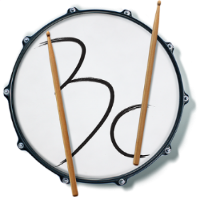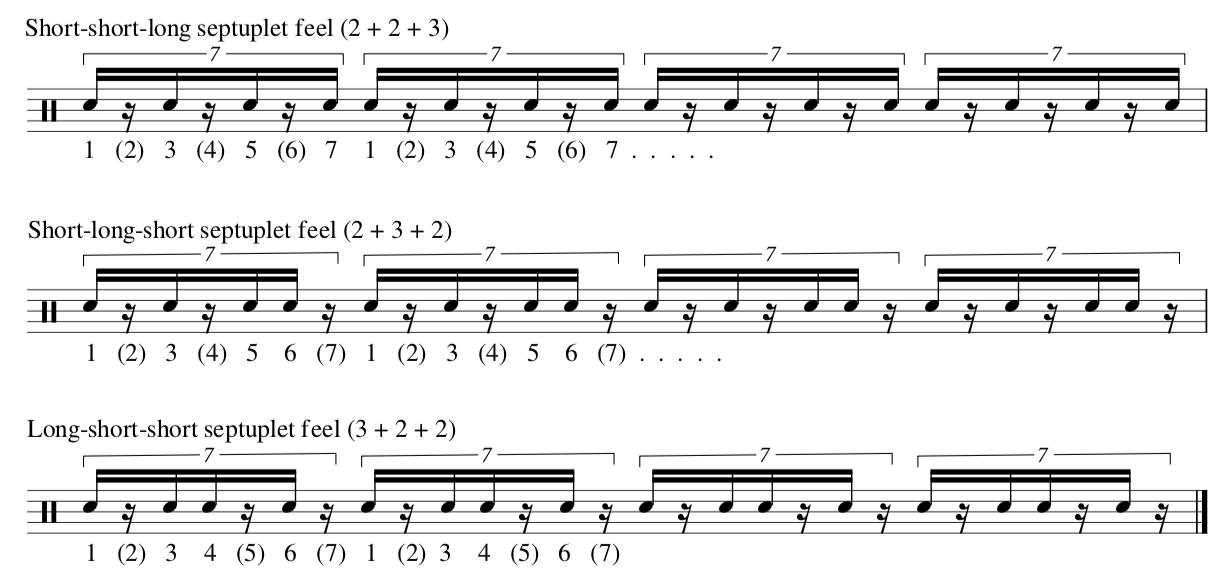Sculpting Rhythms: Quintuplets and Septuplets
As a beginner drummer, you start off with very basic rhythms usually consisting of quarter notes and 8th notes. The complexity increases a bit by getting into 16th notes and triplets. But maybe you’re reading this and you’ve never studied music before and you think, “What the heck are quarter notes and 8th notes?” So let’s back up a bit before diving into the crazy stuff.
Basic Rhythmic Rates and Beat Divisions
Most music has a steady underlying pulse that gives musicians a reference point for building rhythmic patterns, as well as a way to play in time with one another. These underlying pulses, or beats, can be split into smaller parts to create different rhythms. The overwhelming majority of music is built on cycles of 4 beats, known as common time. To begin getting the feel for some basic beat divisions, start with some simple clapping exercises.
We’ll use ACDC’s “Back in Black” to provide a groove that’s easy to follow. Begin by clapping along with the beat, which aligns with the bass drum and snare drum. When your claps sync up with the kick and snare, those are quarter notes, or one clap per beat. There are 4 quarter notes in each cycle of 4 beats. Most other rhythms are achieved by splitting quarter notes into smaller parts.
Try clapping along with the hihats in the song, which play at twice the rate of the kick and snare. The hihats play 2 strokes in every beat; the first stroke is directly on the beat, and the second stroke is in the middle of the beat. You could also think of the hihat rhythm as splitting each quarter note into 2 parts, known as 8th notes. There are 8 8th notes in each cycle of 4 beats.
But sometimes, the drums play a rhythm that’s more broken up and hits in the spaces between 8th notes. By splitting each beat into 4 small parts (or each 8th note into 2 parts), we achieve 16th notes. As the name implies, there are 16 16th notes in each cycle of 4 beats. Starting to see a pattern?
So that covers rhythms that divide beats into 1, 2, or 4 parts, but what about splitting a beat into 3 equal parts? Dividing a beat into 3 equal parts yields 8th note triplets. There are also 16th note triplets, which divide every beat into 6 equal parts (or each 8th note into 3 parts). Triplets feel kind of funky at first when juxtaposed against 8th and 16th notes, but they’re so widely used that people can generally get the hang of them naturally. The Tears For Fears classic “Everybody Wants to Rule the World” is based on a triplet subdivision.
Combining quarter note, 8th note, 16th note, and triplet patterns allows for nearly endless rhythmic possibilities. In actuality, the overwhelming majority of modern music is composed using only those basic rhythmic rates.
But at a certain point, you may begin to feel limited by the more traditional rhythmic grids of 16ths and triplets. You may have noticed that there are some holes in the most common rhythmic grids. Triplets divide beats in 3 parts, 16th notes divide beats into 4 parts, 16th triplets divide beats into 6 parts, and 32nd notes divide beats into 8 parts. But what about dividing a beat into 5 parts? How about 7 parts?
While not nearly as common as 16th note and triplet frameworks, quintuplets and septuplets are gradually gaining popularity in contemporary music. But these concepts aren’t new. In fact, they’re incredibly common in certain styles of traditional eastern European and Indian music dating back hundreds, if not thousands, of years.
Quintuplets
Quintuplets are achieved by breaking a single beat into 5 equal parts. To get extra precise with the terminology, these are known as 16th note quintuplets. Quintuplets can scale to other beat divisions as well. 8th note quintuplets consist of 5 strokes played evenly over 2 beats, and quarter note quintuplets are 5 strokes played evenly over 4 beats. Since they aren’t commonly used in most music created in this part of the world, they almost sound “wrong” upon a first encounter. Thankfully, there are several ways to interpret quintuplets, which make them much easier to internalize and apply to music.
To begin getting a feel for quintuplets, repeat the word “university,” ensuring to say each syllable at an even pace. Since “university” is a word with 5 syllables, it gives us a rough quintuplet framework. It’ll take quite a bit of practice before your ear begins to pick up on quintuplet beat divisions. Since they exist in the space between 16th notes and 16th triplets, there might be a strong urge to snap back into one of those more familiar rhythmic rates.
Dividing the Subdivision
At faster tempos it becomes necessary to break quintuplets into 2 components: a grouping of 3, and a grouping of 2. This translates to a longer pulse followed by a slightly shorter pulse. Or we can do the opposite by playing the grouping of 2 followed by the grouping of 3, which creates a short-long pulse structure. The long-short structure is sometimes referred to as quintuplet swing, due to how similar it feels to a typical swing feel. It’s most commonly heard in modern jazz fusion and hip hop beats. Their viscous feel sets them apart from anything on the 16th or triplet grids. Kneebody’s “Still Play” is a good example of the quintuplet swing feel.
To begin internalizing quintuplets, learn a couple of simple rhythms within each pulse structure. For the long-short structure, clap on the 1st, 3rd, and 4th parts of each beat. The 1st and 4th parts are the strong portions of the beat, while the 3rd part of the beat should feel like the skip stroke of a swing pattern played on a ride cymbal. Start playing very slowly to prevent yourself from accidentally slipping into a triplet rate. If played properly, it should have a limp almost the same way a shuffle does, but with even more of a sputtering quality.
For the short-long pulse structure, clap on the 1st, 3rd, and 5th parts of each beat. In this case, the 1st and 3rd parts are the strong portions of the beat, while the 5th part is the equivalent to the ride cymbal skip stroke mentioned earlier. While not quite as common in contemporary music, this rhythmic structure is especially prevalent in traditional Balkan music and dance. But they’re frequently expressed as the time signature 5/8 or 5/16. While quintuplets might feel pretty weird at first to people who grew up in the US listening to pop music, people that grew up in India or the Balkans may have been exposed to these rhythmic forms early on through cultural traditions. The below piece is an example of a Bulgarian dance song using the short-long pulse.
Septuplets
Septuplets are another rhythmic rate that’s gradually finding its way into more modern music. As the name implies, septuplets are achieved by splitting each beat into 7 parts. Like quintuplets, they sort of fit in the space between two other rhythmic rates: 16th triplets and 32nd notes. And also like quintuplets, septuplets become much less intimidating when we break them into smaller, more manageable bits. But since we have more beats, there are more ways to fragment them.
We can begin to simplify septuplets by thinking of them as a grouping of 4 and a grouping of 3 (long-short structure), or a grouping of 3 and a grouping of 4 (short-long structure). More specifically, we can split those groupings of 4 into two groupings of 2. That allows for even more flexibility with where we place the stresses of each beat. Instead of only 2 strong pulses per beat, we’ll have rhythms with 3 strong pulses per beat. Septuplets can be broken into groupings of 2 + 2 + 3, 2 + 3 + 2, and 3 + 2 + 2.
With the 2 + 2 + 3 form, clap on the 1st, 3rd, 5th, and 7th parts of the beat. It feels like playing 4 steady 8th notes, but the last note gets cut short. The stresses are on the 1st, 3rd, and 5th parts of the beat, while the 7th part acts as the skip stroke. In simpler terms, the structure is short-short-long. The performance of Bulchenska Ratchenitsa by Ivo Papasov’s band is largely based around the short-short-long structure. It’s just played VERY fast.
Following the same line of thought, the 2 + 3 + 2 structure feels like short-long-short, and the 3 + 2 + 2 structure feels like long-short-short. Each rhythmic arrangement is accompanied by different dances and songs.
Septuplets have not yet been integrated to the same extent as quintuplets in contemporary music, but they aren’t totally unheard of. The best way to learn and utilize them is to practice clapping the above rhythmic structures and listening to music that’s based on a septuplet division, the same method used for learning quintuplets.
As far as contemporary music goes, the use of septuplet grooves is generally isolated to jazz fusion, or progressive styles of music, like Anika Nilles’ performance below. But leave it to traditional Balkan culture to create dances that conform to those rhythmic structures. Associating dances to particular rhythmic forms is an excellent way to organically learn those cadences.
Once you have quintuplets and septuplets internalized and your ear is more tuned to how they sound, you’ll definitely want to begin exploring their potential in your own playing. As always, start off playing slowly to prioritize accuracy over speed. You’ll naturally want to shift back into the comfortable grids of 16ths and triplets, but that urge diminishes as your muscle memory accommodates these new rhythmic rates. With enough practice, they’ll feel as comfortable as 8th notes, triplets, and 16th notes.
Want to take a deeper dive into how to apply quintuplets and septuplets to the drums? Schedule a trial lesson to get closer to your goals!







